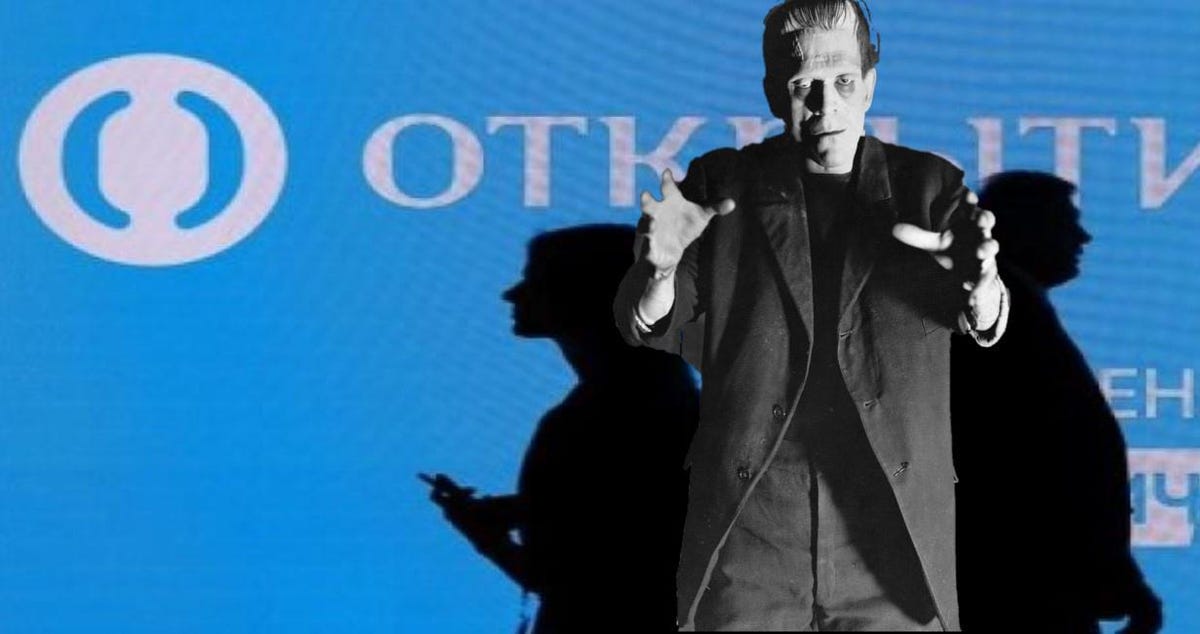
Otkritie Bank, once one of Russia’s “too big to fail” banks, has been wholly owned by the Central … [+]
It’s alive!
Once one of Russia’s premier non-state owned bank, Otkritie (means “Discovery” in Russian), died, went to heaven (at the Russian Central Bank) and is now resurrecting. Otkritie is coming back to life, and ready to leave the control group at the Central Bank of Russia (CBR.) An initial public offering is on the table.
If it happens, they would list on the Moscow Exchange. It would be a huge hit, I am convinced.
The Russian Central Bank took over Otkritie in 2017. It was the country’s 8th largest lender at the time. At the time, the bank had hit a wall after years of employing an aggressive M&A strategy, acquiring the Rosgosstrakh insurance company and National Bank Trust. Otkritie’s balance sheet almost tripled between 2015 and 2017. The Central Bank, under Elvira Nabiullina, was worried that private sector banks had bitten off more than they can chew and would lead to a banking crisis in Russia. She was one of the main architects of sweeping up dozens of private banks and basically putting them under CBR stewardship for years to clean them up.
The shift to state-control of Otkritie Bank increased the state’s role in Russia’s banking sector to levels not seen since the Soviet Union days. Now we are moving in the other direction again.
Otkritie grew out of the post-Gorbachev years in Moscow. It was forged out of the implosion of the Soviet system, when many entrepreneurial Russians — most with political connections — began to rapidly earn capital and build new business empires from scratch or on the ashes of what was previously under state control.
There as just one state owned bank in Russia pre-Gorbachev, with a few subsidiaries that served the entirety of the Soviet economy. It wasn’t until the 2000s that nearly a thousand privately owned financial organizations began sprouting up nationwide. Otkritie was one of the biggest, thanks in large part to its Moscow corporate banking focus at the time.
The Asian Tigers crisis, the 2008-housing crisis that led to a mortgage backed derivatives market collapse in the U.S. and Europe, all had their own impacts on Russian banks that often borrowed from American and European lenders in dollars and euros.
MORE FOR YOU
The Russian banking system became unstable within a decade of being formed and many banks collapsed, lost (or stole) their client’s money.
Russia’s Central Bank Governor Elvira Nabiullina: I saved Otkritrie Bank. Спасибо! (Photo by Artyom … [+]
That’s when Nabiullina stepped in. She took over the Central Bank in 2012 and made it her primal goal to clean up the private banking sector and change its management model. Otkritie was arguably the most famous of the big banks to get captured first.
“We need to take out these zombie banks and we will, one by one,” MIT-educated Ksenia Yudaeva, the first deputy governor of the Russian central bank, said at the time. Most of these banks were not publicly traded so they had no major impact on the market, other than helping money flow to Sberbank, which is arguably the best run, but state-controlled, big bank in Russia.
Over the last five years, Sberbank’s share price in dollars has gone up 38.6%, while the VanEck Russia ETF (RSX) has gone up 30%.
The CBR mercilessly took away licenses and shut down small regional and large banks over a five year period ending around 2017. Otkritie was the largest to be taken over, then considered a “too big too fail” bank in Moscow.
At the time, thanks to its aggressive M&A program, Otkritie had assets of over $50 billion, which is a lot of rubles.
When word came that the CBR was considering taking her over, clients began withdrawing funds from the bank and it started to buckle. In typical Russian fashion, its owners fled the country.
Vadim Belyaev and his partner, senator and real estate magnate Boris Mints, are the main men behind Otkritie. They started it around 2006. By 2013, the bank was widely regarded as a vehicle for Anatoly Chubais, a well connected Russian businessman and considered Boris Yeltsin’s right hand man when it came to talking to the International Monetary Fund in the 1990s to reform the Russian economy. Chubais later became a shareholder in Otkritie, a fact confirmed by a short announcement in 2013 announcing Chubais was selling out his position to Belyaev and the bank’s manager at the time, a man named Ruben Aganbegyan.
Ben Aris from BNE IntelliNews, writing about the bank’s take over in 2017, said that Chubais was the main character behind Russia’s notorious loans-for-shares privatization in the Yeltsin years. He famously allowed oligarch Boris Berezovsky to fix the privatization of telecom giant Svyazinvest. He was considered close to the well connected business/political powers of Moscow and got a $100,000 “book advance” fee from famous billionaire Vladimir Potanin in the 1990s to write about Russia’s privatization post-Soviet Union.
Some commentators speculated that one of the reasons the CBR was slow to take over Otkritie as because Nabiullina worked as Chubais’ deputy in the Committee on Economic Reforms in the 1990s and didn’t want to lose his friendship. Aris’s view is that “the CBR has been remarkably generous with Otkritie” and gave it ample funding in its bailout.
It is unclear if any of these players will still be part of Otkritie, other than, perhaps, as shareholders. A new management team has been brought on board.
The situation with Otkritie is sometimes compared to the U.S. government’s decision to take a nearly 40% stake in Citigroup to infuse it with capital when the U.S. subprime mortgage crisis hit in 2009.
CBR went way farther, taking full control of Otkritie in the summer of 2017. It took roughly two years to clean it up.
Nabiullina was credited with keeping Russia’s banking system alive. Not only did Otkritie survive, the bank is supposedly in much better shape and ready to leave the CBR nest.
The CBR cleared the bank’s balance sheet by consolidating all the bad assets into a “bad bank” Trust and has so far recovered 221 billion rubles from 482 billion rubles in assets.
Otkritie is alive and kicking. Russian investors often consider it one of the most transparent banks around, is not a black box any longer, and follows Russian regulations. Although the company is actively investing in technology and IT infrastructure, it is being resurrected as a traditional banking business with a large network of offices in all Russian regions — focused on commercial and retail lending and savings.
Otkritie has maintained its successful asset management and securities brokerage business with a focus on retail clients. This side of the business now accounts for a significant part of the company’s income.
From the latest numbers from the CBR, Otkritie nearly doubled its net profit to 58.7 billion rubles ($832 million) in the first nine months of 2021. Net interest margin rose 4.8% from 3.9% in 2020. Otkritie is set for an all-time record profit since its gone through the CBR bootcamp.
The next step is for CBR to reduce its ownership stake.
The famous neon-blue Otkritie sign in Moscow. Photographer: Andrey Rudakov/Bloomberg
In 2019, Nabiullina, once considered the leading central banker in the world by Euro Money magazine, said the final goal was always to take Otkritie public. This was supposed to happen last year. Then a pandemic hit. All hell broke loose. We know the drill.
Assuming she is sticking with her stated goal, and banking insiders I’ve heard from are trusting she will, then one of Russia’s fastest growing banks is about to go public, probably within a year. It’s share offerings will likely be similar to what happened with Citigroup when the U.S. reduced its stake until it had nothing left.
Citi’s stock has nearly doubled since the financial crisis. If Otkritie’s IPO happens, and the bank can stand on its own, it will probably see a similar investor outcome — only, perhaps, more wild as this is an emerging market and Russia is the wildest of them all.







